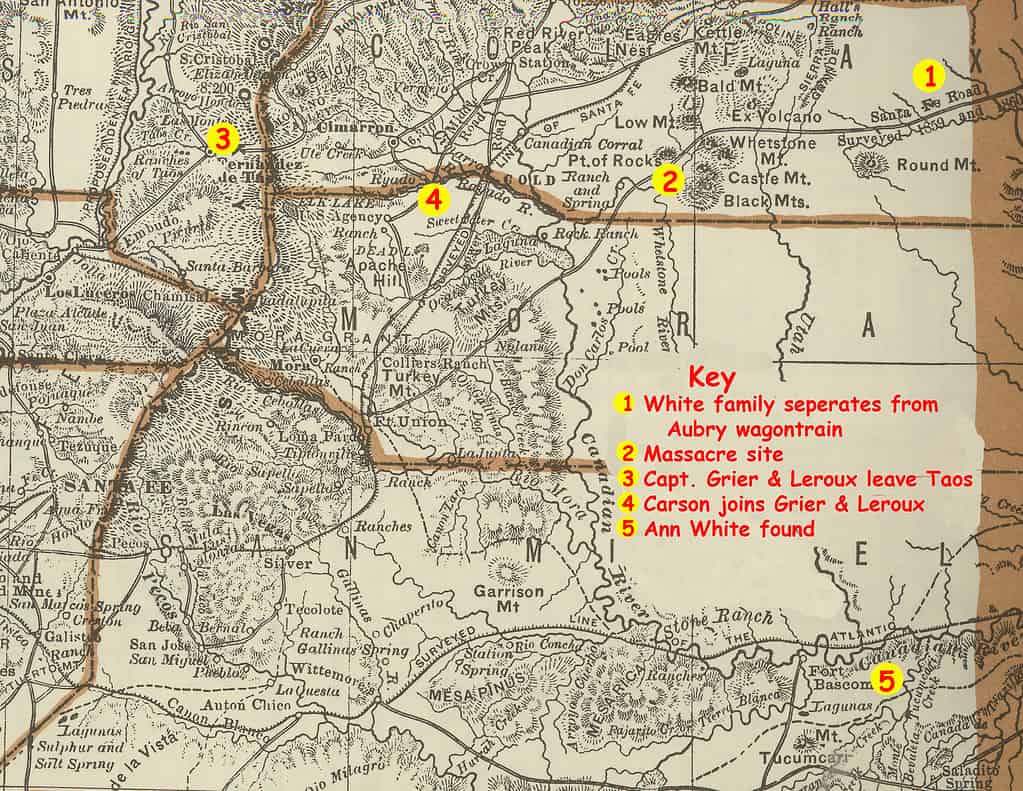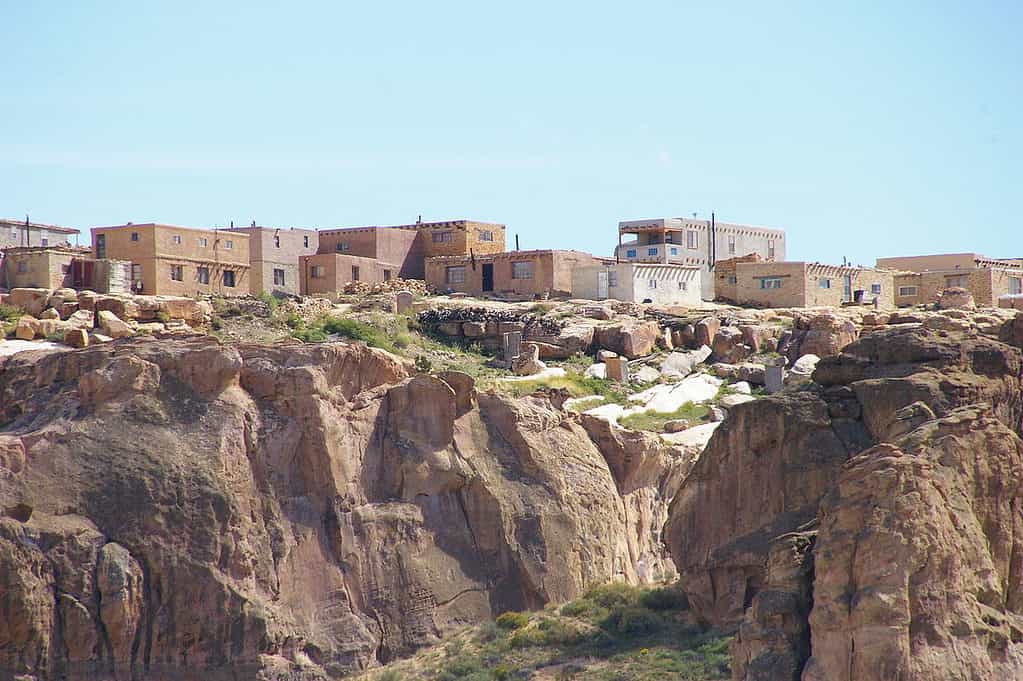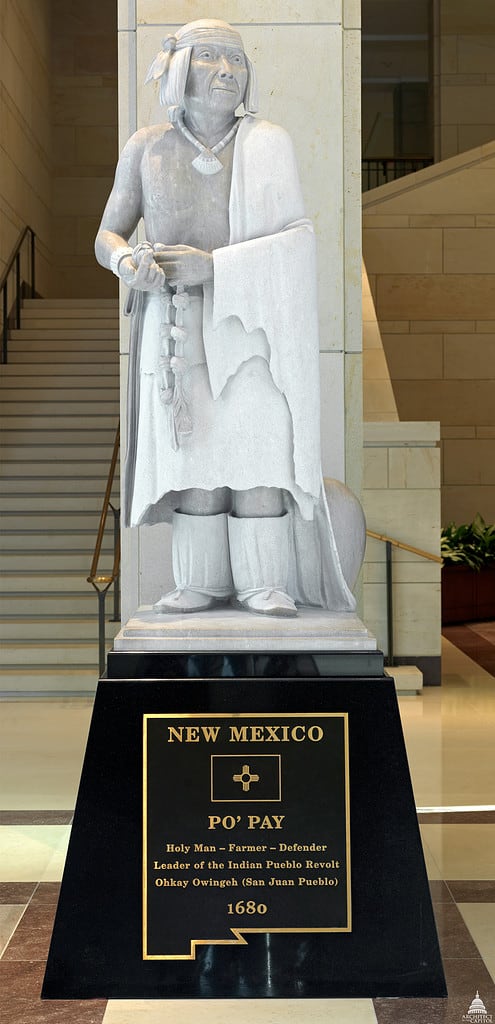With its stunning scenery and rich history, it’s no wonder New Mexico is called the “Land of Enchantment.” From rugged mountains and colorful cliffs to endless skies and dramatic sunsets, New Mexico has plenty to marvel at. The state’s rich history is intrinsically bound with these iconic landscapes, including countless battles over several centuries. Let’s dive in and discover the seven most historic battlefields in New Mexico!
7. The “Long Walk of the Navajo” (1864-1866)

The Navajo were forced to abandon their homes and travel for hundreds of miles.
©U.S. Army Signal Corps / Public domain, via Wikimedia Commons - Original / License
Some of the most historic battlefields in New Mexico come from the Navajo Wars. Following the Mexican American War, the United States and the Navajo engaged in a multitude of conflicts, from cultural clashes and land disputes to ongoing raids on both sides. The conflicts continued until 1863 when Colonel Kit Carson led the U.S. Military to subdue the Navajo and Mescelaro Apache peoples. They chased the Navajo for several months, burned their hogans and crops, and took their livestock, leaving the people without food or shelter during the winter. By 1866, several Navajo groups and their leaders were forced on what is now called the “Long Walk”, traveling several miles from their homes to the reservation at Fort Sumner in New Mexico.
6. The White Massacre (1849)

Before separating, the White family had been traveling with an experienced wagon master.
©User:Carptrash / CC BY-SA 3.0, via Wikimedia Commons - Original / License
In October 1849, James and Ann White headed west toward Santa Fe, New Mexico. After passing through what they thought would be the most treacherous part of the journey, the group encountered a band of Utes and Jicarilla Apaches. Although they drove the natives away, they returned, asking for presents.
When they returned a third and final time, the group of natives attacked and killed most of the white settlers. Only Mrs. White, her young baby, and a servant survived and were taken by the natives. Soon after a United States Army Cavalry embarked on a rescue mission, but tragically Mrs. White was killed. Her baby and servant were never recovered.
5. Taos Revolt (1847)

The rebels of the Taos Revolt hid inside a church that was destroyed during the battle.
During the Mexican American War, the United States Army claimed a large area of land in what is now New Mexico, including Taos. The residents of Taos included both Mexicans and Native Americans, and they were not pleased with the new arrangement. The governor promised that they would be treated respectfully, but the soldiers took their food and provisions and abused their women.
The governor petitioned U.S. forces to take control of their soldiers, but to no avail. After several months of this poor treatment, the people in Taos planned an uprising. Led by Pablo Montoya and Tomás Romero, they revolted on January 19, 1847, and killed the governor. The revolt traveled across northern New Mexico, continuing to harass and kill any American inhabitants they crossed paths with. A battle with the U.S. Army ensued on January 21, after which the rebels surrendered.
4. Ácoma Massacre (1599)

The Acoma Pueblo community in the Rio Grande Valley sits atop a large mesa.
The Acoma people had lived in the Acoma Pueblo (Sky City or Old Acoma) for at least a thousand years before the Spanish arrived. However, in 1598 Juan de Oñate brought 500 colonists and 7,000 livestock animals to the region, declaring that it was now a Spanish territory. He declared that the natives must become Catholic and were now subject to the King of Spain. However, when the Acoma Pueblo people refused to give up their essential winter supplies to his soldiers, Oñate retaliated and set fire to the Pueblo, massacring around 800 villagers. Each male survivor had one of their feet cut off, and the women and children became slaves.
Pueblo Revolt (1680)

A statue of Po’pay stands in the National Statuary Hall.
©USCapitol / Public domain, via Wikimedia Commons - Original / License
Led by the Tewa leader Po’pay of Ohkay Owingeh, the Pueblo Revolt took place in Santa Fe de Nuevo México, a province of New Spain during the Spanish Colonization of the Americas. For many years the Spanish government oppressed the native Pueblo people in the region, forbidding their religious practices and forcing them to convert to Christianity. In 1680, the Spanish governor ordered many of the Pueblo holy men to be publicly whipped and executed. In addition, the Pueblo people were also suffering from long and terrible drought and could not pay the hefty taxes the Spanish government imposed.
Various Pueblo villages and groups organized a collective rebellion and successfully drove the Spanish out of New Mexico for 12 long years. When the Spanish finally returned, they chose to try to work with the people rather than against them.
2. Battle of Valverde (1862)

The Valverde battlefield was right along the Rio Grande.
©Miscellaneous Items in High Demand, PPOC, Library of Congress / Public domain, via Wikimedia Commons - Original / License
During the American Civil War, the Confederate Army attempted to invade and take control of the southwestern United States. During their campaign, they fought the Union Army near Fort Craig in the New Mexico Territory in 1862. The Battle of Valverde lasted for two days in February, and both Union and Confederate forces suffered many casualties. Ultimately, however, the Confederate Army was victorious, and the Union forces retreated to Fort Craig.
1. Battle of Glorieta Pass (1862)

Losing supplies forced the Confederate Army to retreat, despite almost winning the battle.
©Roy Andersen / Public domain, via Wikimedia Commons - Original / License
One of the most historic battlefields in New Mexico is in Glorieta Pass near Santa Fe. The Battle of Glorieta Pass is considered the “Gettysburg of the West” because it played such an important role during the American Civil War. The Confederate Army wanted control of the West and planned to move from Texas to the western coast. However, they didn’t make it past Albuquerque and Santa Fe in New Mexico because of the Battle of Glorieta Pass.
In 1862, Confederate soldiers were traveling along the Santa Fe Trail when they were ambushed by the Union army. The ensuing battle lasted three days while the two sides fought amid the freezing snow. The next day they waited for reinforcements, rejoining the battle on the third and final day. As the battle at Glorieta Pass raged on, a group of Union soldiers discovered the Confederate supply camp and burnt it to the ground. The Confederate Army had pushed the Union soldiers back, but without their vital supplies, they ultimately were forced to retreat, their path to the west now cut off for good.
Summary of the 7 Most Historic Battlefields in New Mexico
| Battle | Location | Who Was Involved | Year |
|---|---|---|---|
| Battle of Glorieta Pass | Glorieta Pass near Santa Fe | The United States Union Army and the Confederate States Army | 1862 |
| Battle of Valverde | Valverde (near present-day Socorro) | The United States Union Army and the Confederate States Army | 1862 |
| Pueblo Revolt | Santa Fe de Nuevo México | Spanish colonists and the Pueblo | 1680 |
| Ácoma Massacre | Acoma Pueblo | Spanish colonists and the Acoma | 1599 |
| Taos Revolt | Taos | Mexicans and Pueblo allies and the United States government | 1847 |
| White Massacre | Northeastern New Mexico | United States settlers and a band of Utes and Jicarilla Apaches | 1849 |
| “Long Walk of the Navajo” | Western New Mexico Territory (present-day Arizona) to Fort Sumner (eastern New Mexico) | The Navajo and the United States | 1846-1866 |
The photo featured at the top of this post is © John Phelan / CC BY 3.0 – License / Original
Thank you for reading! Have some feedback for us? Contact the AZ Animals editorial team.







